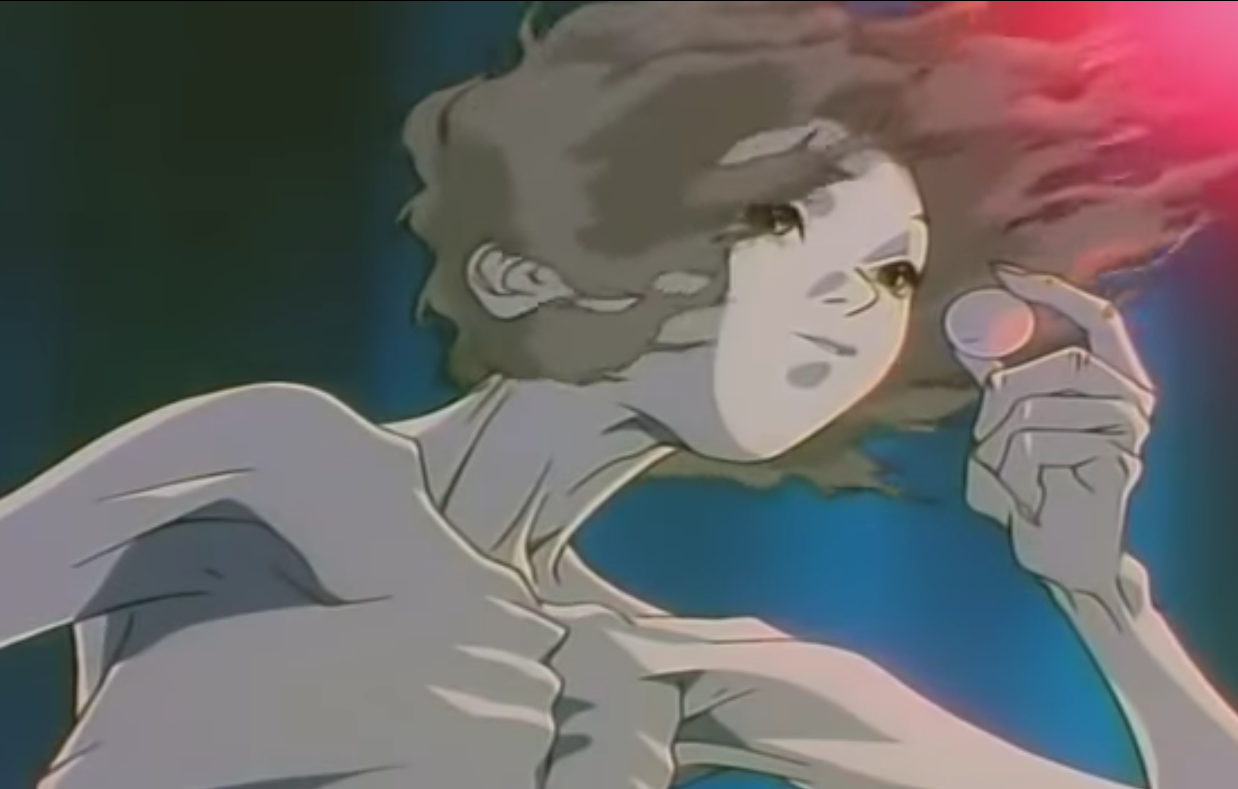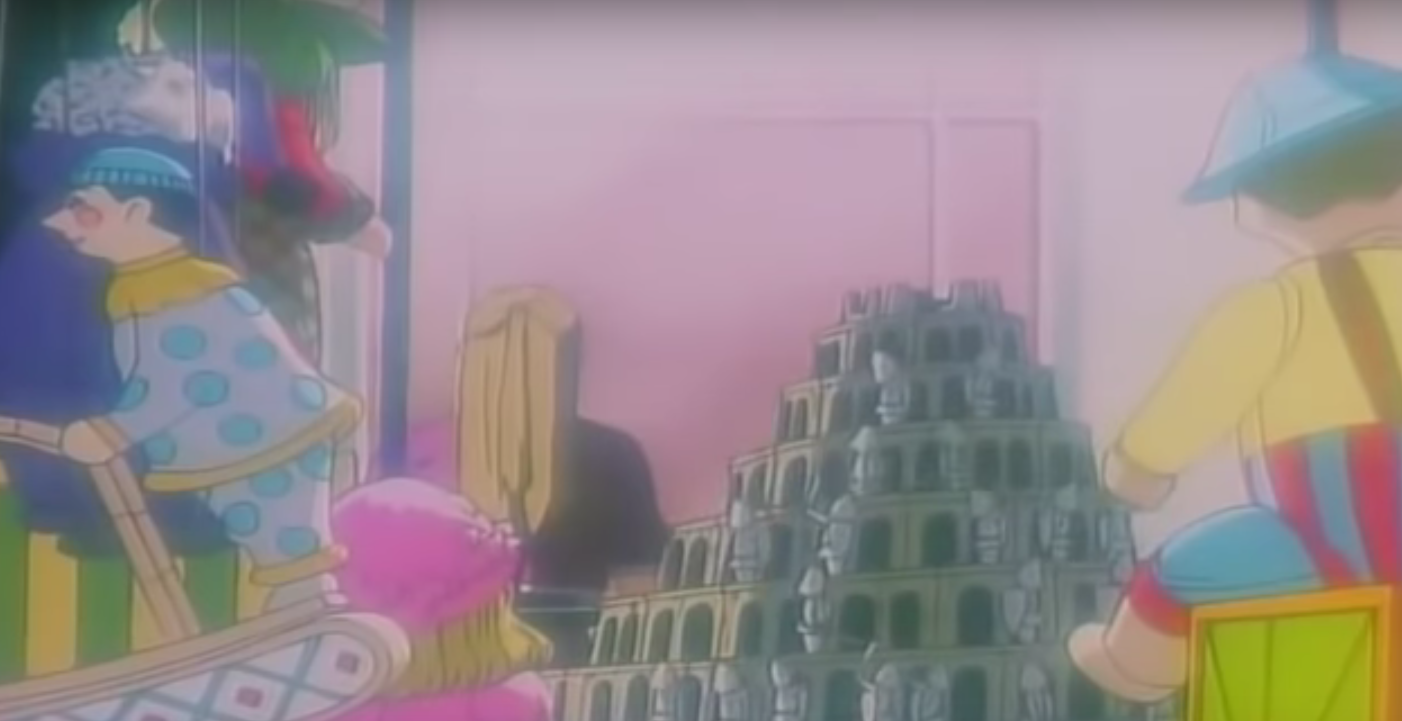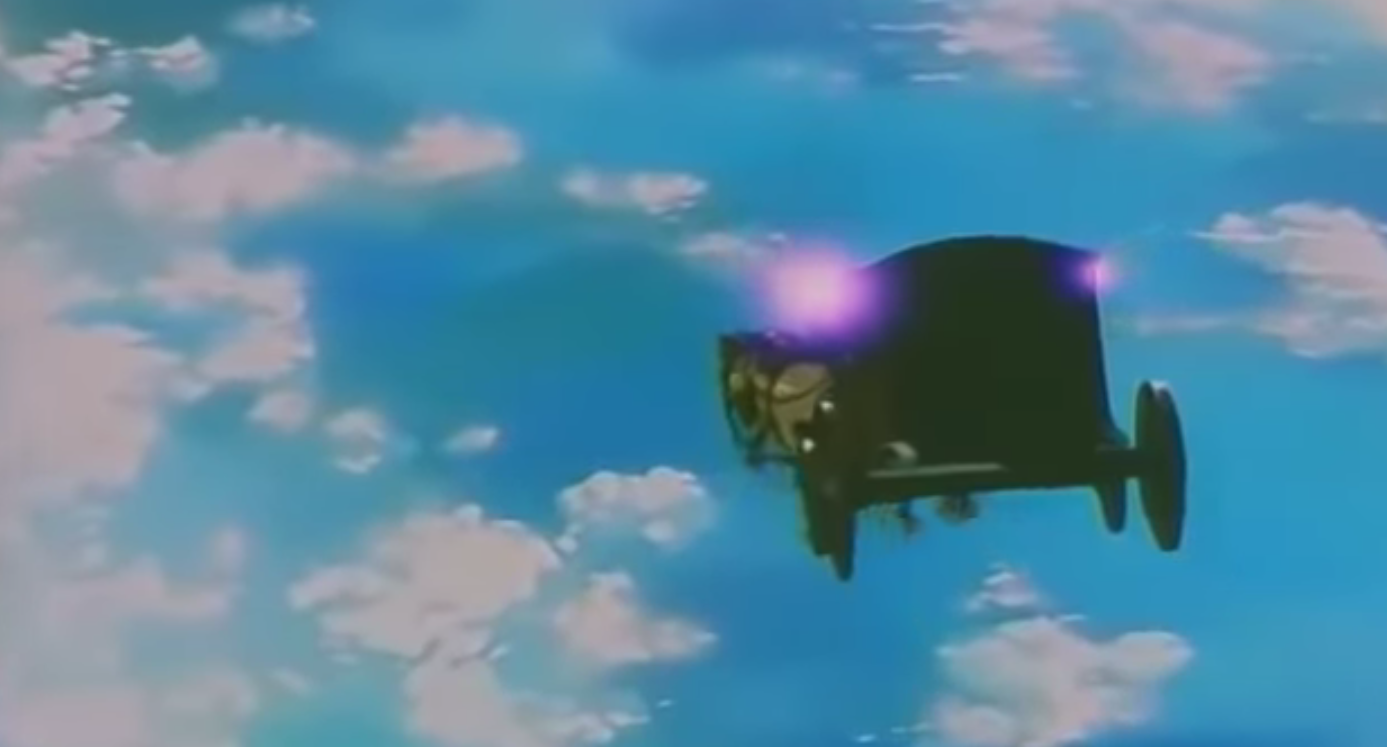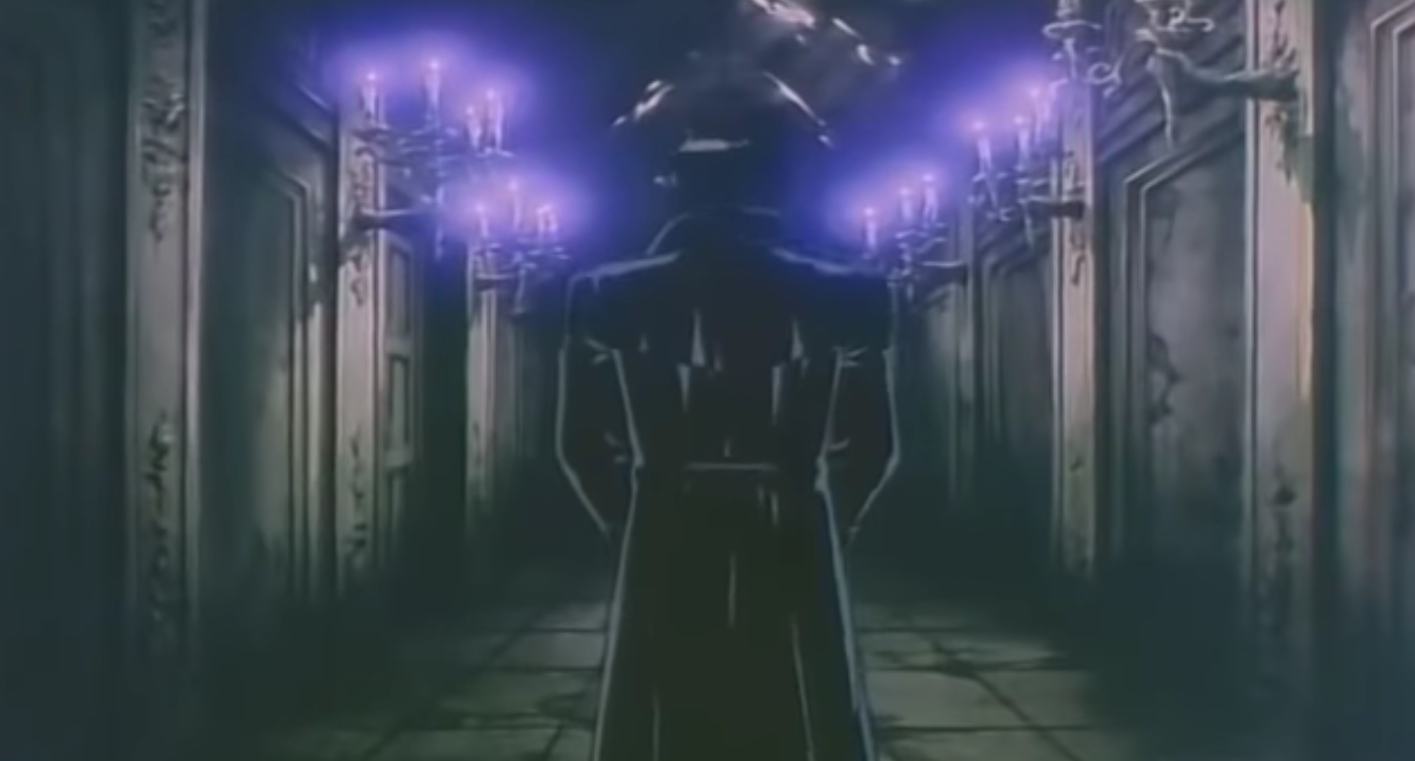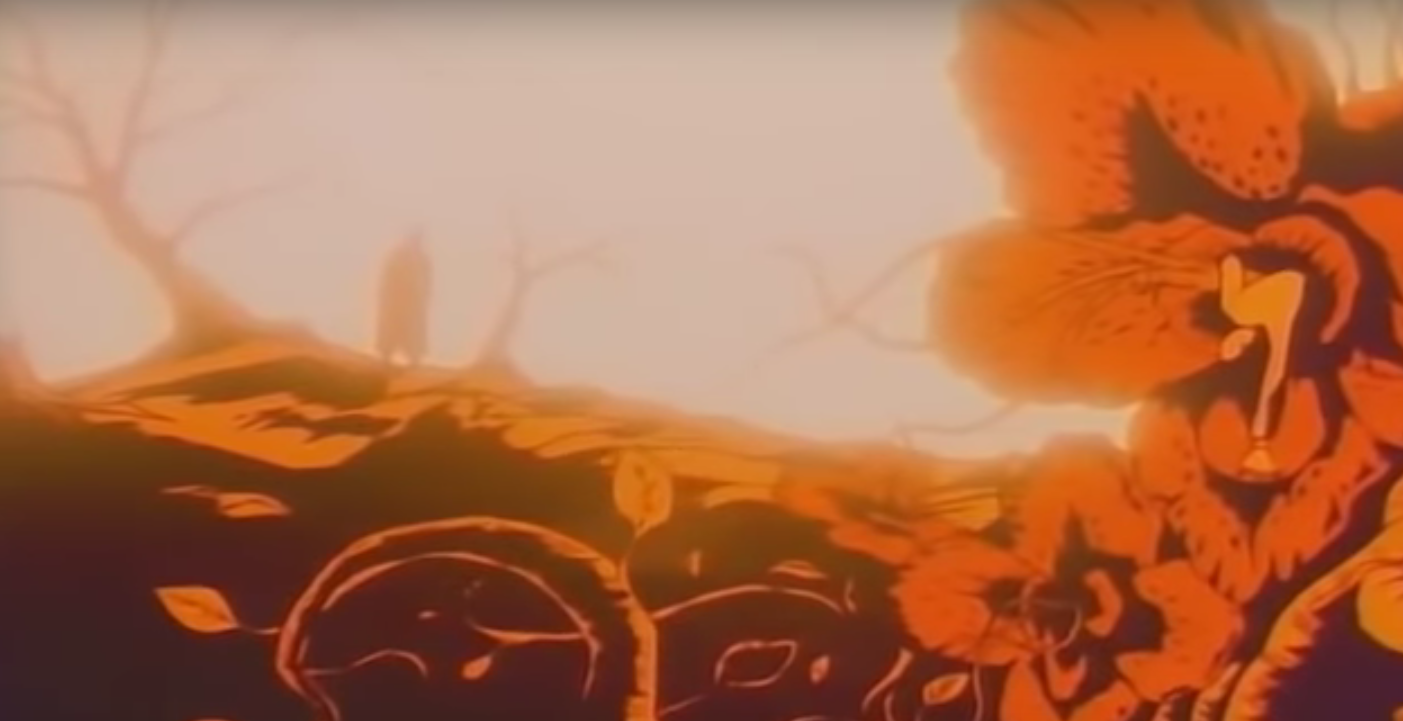The film selected for this game was done so before any of the participants had seen it or knew much about it. The questions were compiled relatively quickly based on associations, chance, random ideas—risking everything on certain weird hopes and projections, and trusting that they would all in one way or another find their mark.
The idea was to use the surrealist method of irrational enlargement—classically applied in the 30s to Chirico’s painting and films like The Shanghai Gesture—this time on those strange but beautiful anime creations that we knew from our youth that drew so largely upon the gothic and so little upon conventions of logic or narrative.
Any film might have worked with such an open-ended method but still, this one was an uncannily good choice. It turned out that the game was eminently suited to such a bizarre creation where so much extrapolation is needed naturally to explain even a superficial watching. In that sense a few of us have since come to consider Darkside Blues as a minor revelation, and stands in retrospect as a high point in the highly messy and popular experimentation happening in anime films that occurred during the 80s and early 90s. These centered around strange, morbid and oftentimes erotic releases, theatrical or direct-to-video, where both censorship and logic had less sway. For whatever (economic, social, psychological) reason this seems to have tapped into some rich, lurid vein of creativity in the anime film industry and their audiences of the time.
This is a film that brings mythic entities mysteriously close to reality, as if an approaching celestial body, and does not ruin it by explaining them. Like a real encounter the explanations come from us after the fact. Certain films talk to us about strange things; other films make us encounter them ourselves, and talk very little. The pacing here leads one to remember the film in any order, or perhaps a simultaneous order, the kind of interleaved confusing of distinct episodes that is absolutely reminiscent of the dream. Considering the film itself concerns itself with “dream treatment”, a strange sort of rejuvenation, the oneiric atmosphere gains even more credibility.
Of note is the unexplained but heavily traversed Mirage Hotel, where people seem to get the kind of encounter they subconsciously seek for or deserve. Equally vague is the process of “renewal”, practiced by Darkside as a kind of guided therapy—a mental re-orientation of the world based on hidden, fundamental desires and memories. We were likewise compelled by the image of the gravity defying horse-drawn carriage (which turns out was collectively given the character of a submarine in several of our responses). Simmering beneath the confusion is a pulpy plot dealing as with a technology-centric corporation in a war to snuff out the last independent and rag-tag gang of semi-unconscious revolutionaries left. And all this, evoked by an equally unlikely blues anthem.
But beyond just certain striking moments, an elegantly ambiguous and extremist narrative, or its strong atmospheric considerations, Darkside Blues gives us in the end one of those indigestible kernels of mythic fragments that stay with us because of their standalone nature. Aloof, weird, definitive, inexplicable and violently burlesque, a dream and a role-model—for action..
-JA
The Game
What thoughts does our lead character have, on the very last moment that you see them?
JA: He’s thinking about a painting he saw in a dream, depicting a satellite covered in blueberries.
L: You know when you go to bed drunk, and you stagger to the bathroom in the middle of the night for a pee, and then you collapse back in bed, roll over, and it’s like the fog of sleep is shooting out your ears? And maybe, just maybe, you ask yourself, “Wait, am I the main character of my own life? Or is it that guy?”
CC: What mischief to concoct next.
SC: “So, what’s for breakfast?”
AL: Doubts about his manhood, his love interest’s connection with her dead father.
ML: It is time for a nap.
D: Am I a hermaphrodite? Will I ever find love?
RM: Evaporating through Katari’s bauble, I follow the horse-drawn helicopter into the Himalayan stronghold of the spiderclock, striking 13 at the very moment a dead cat turns to gold. The nuns keep my rifle loaded behind the falcon’s wings, and a bleak harmonica loads enhanced human thigh bones and dolls with rockets in preparation for the alchemist’s vial of sleeping gas.
TL: Our hero becomes lost in a resurfacing memory of tongues that penetrate the rose-coloured Sahara at distant intervals, reaching across the desert and coiling with one another, stroking a half-buried vulva, licking strange cartouches into the sand with undulating motions, exchanging follicles and pollen.
Do you consider this film aquatic, or land based?
JA: This film is entirely aquatic. It obviously takes place in an aquarium.
L: Aquatic. The horse and carriage is clearly an advanced form of submarine that can treat even solid matter as water.
CC: Aquatic. Water drips from city orifices and populates internal worlds.
SC: Likely aquatic, numerous water fountains are glimpsed throughout.
AL: Land based, with the exception of a bottled hallucination
ML: Aquatic
D: Land-based
TL: Land-based, definitely. Mentally I place it in the world of Gomphotherium.
If this film was turned completely inside-out, what other film would it be?
JA: It’s a complete inverse of the Christmas rom-com, Love, Actually.
L: An American slice of life comedy film about the white-collar hijinx of family-oriented suburbanites working at Persona Century Corporation.
CC: Fern Gully
SC: Atlas Shrugged? Porky’s?
AK: Light Yellows
ML: Little Miss Sunshine.
D: The Magnificent Seven
TL: Santa and the Ice Cream Bunny (1972)—the spectacle of Santa’s sleigh stuck in the Florida sand, requiring the intervention of a gorilla and the otherworldly Ice Cream Bunny, parallels the interdimensional figure in the horse-drawn carriage, despite being his dialectical opposite.
At what point in this film does a submarine (any submarine) gain highest importance?
JA: The main character Darkside has a horse-drawn chariot that is actually a submarine (again, because the film takes place underwater in the aquarium). At one point he offers to give the delinquents a lift, giving them a scenic overview of the flora and fauna of the aquarium, not unlike in a Jules Verne novel.
CC: The submarine, Kitari, is important throughout the film.
SC: The carriage on which Darkside appears, an obvious submarine, is seen cutting up through the old city pavement like milk. In a blackhole talespin, he is both the grand finale, and the opening act—combined.
AK: In the film’s sequel, a submarine is found beneath Shinjuku. Mutants are hiding inside.
ML: During the clickity-clacking of a deep time portal.
D: At the bar, when she throws her drink.
TL: At the moment when Darkside asks the grandmother, “Why don’t I do something for your cat?”
What is the main character’s pet (or pets), and where do they keep it?
JA: Darkside has a pet rock with googly eyes that he keeps close to his heart.
L: Darkside keeps a pet wyvern in his underpants. Mai and Kenzo keep an abused dancing bear locked up in its own filth in the garage, ’cause they’re delinquents.
CC: A rifle, which rests on her shoulder. A transparent sphere, which he holds in his hand.
SC: The ground beneath her very feet is “pet”. The city, the skyscrapers, all “pet”, too. all is comrade, all is kin, to this plucky heroine.
AK: Six iguanas in his mind, all of them representing his favorite birthdays. One goldfish beneath his bandages.
ML: Chinchilla, under his carpet.
D: Katono, on a short leash.
RM: Darkside’s electric mongoose burrows in the holes of time, sinking teeth into orbital cobras before they can cut through the crimson spider silk that holds back the avalanche
TL: The first is a member of the species of prehistoric Arctic hyena whose fossil remains have been discovered in the Yukon, I believe named Ulrikke. She spends most of her days in the hosiery drawer, making unintelligible alchemical constructions with brassieres. Her wife is a cassowary the size of a dime named Sfogliatella. She feeds exclusively on the underarm hairs of castrated male Jane Austen novel characters and is only comfortable nestled deep in an armchair covered in clothes that have not been folded and put away. There is also another animal whose name I don’t remember, maybe a multituberculate, who has claimed a giant plastic bag filled with other plastic bags for their territory within the house. Together their synchronized activities prevent the dissolution of the human capacity to maintain adequate intestinal function.
What is the significance behind the red-haired woman’s jacket?
JA: The character with red hair has a skimpy vest that refers to their subculture—“Lampists”, that is someone who loves to dress as if they are in the Tale of Aladdin.
L: All jackets in this film are ethically-sourced and environmentally friendly products distributed by the tailors responsible for the emperor’s new clothes.
CC: Her jacket is shaped like a vest and turns her into a man.
SC: None appeared, therefore the blues man & his harmonica shall commit mushy cosmic seppuku. An unavoidable misfortune…
AK: Her unrealized struggles with gender dysphoria
ML: To hide the baby cannon.
D: It held a missile launching baby.
TL: The emotional turmoil experienced by a small child punished for defecating in the bathtub.
In the second scene, an item of deep symbolic importance to the film shows very briefly. What is that item? And what do you think it means?
JA: The item in question is a quick burst of steam coming out of a random pipe. It consumes a huge portion of the screen very briefly. I don’t know exactly what it means but I think it must have something to do with the euphoric release felt by the characters when they start committing acts of gratuitous violence (as in that very scene, which involves torture). There is a violent death later on in the film that liberates a formerly cynical pacifist character to commit herself unequivocally revolutionary violence. One gets the sense that the violence is quite pleasing to the characters in an erotic sense too.
L: The gold-statueifying electrodes are a clear metaphor for primitive accumulation under state capitalism
CC: A golden torso. An attempt at transfiguration and purification that succeeds only in stripping away humanity.
SC: Spinning Spider—symbolically crucified, he will be the stand-in for Pure Void.
AK: A woman’s torso that’s turned into gold. It likely has something to do with the film’s brief fixation for Africa in earlier scenes.
ML: A suit of armor, a Midas touch.
D: Gold, it’s heavy.
RM: The boiler room torture shows a momentary escape of steam, followed by the swooping of the falcon. Both represent the film’s soul in different states. Vapor flies through cracks and joins the sky. It forms images freely and abandons them as freely without losing its substance; the falcon’s flight however is restricted to the basement by the will of the sadistic heiress who demands recognizable plot structures, characterization, etc. At times the film is vaporously free of these, at times imprisoned by them and therefore less exciting yet nonetheless energetic.
TL: For a split-second, there is hidden a miniscule copy of the second and third volumes of the Iconographie photographique de la Salpêtrière in the corner of a frame. For the viewer with heightened perception, this item provides the key to the unusual behaviour of the colours we see and illuminates how the events of the film and decisions of the characters are predetermined by these colours. Any audience member who discerns it will inevitably begin to channel the spirit of a cannibalized Homo erectus thirty-six days from the viewing of the film.
The main character’s love interest has a secret animal form. Can you guess it?
JA: Her long orange hair leads me to believe her animal form is a fox.
L: He turns into a black stallion, thus explaining his love of carriages. All little girl’s have a horsey phase.
CC: An insect, specifically a cricket.
SC: Gorilla, or possibly rhinoceros.
AK: A sad newt.
ML: Prairie dog.
D: Wombat, or maybe sloth.
TL: A New Zealand glowworm.
Benjamin Péret was hired as a ghost-writer for a single line in this film. What line is it?
JA: “Number 11 Crystal Street… That way?”
L: “Did you just say something aggressive in casual conversation?”
CC: “Fools and delinquents go to high places like the fool on the hill.” “But he’s dead and rotted to the molecule. You’re doing useless magic.”
SC: Actually, it was Benjamin Péret who originally wrote the lyrics to that gibberish blues song, a rather bad year…
AK: “Excuse me, I examined you without your permission.”
ML: “He is dead and rotted to the core”, or “your darkness is darker than my darkness”.
D: “I’ll carry on his determination”
TL: “That woman’s face was darker than my darkness.”
At what point in this film does the Jupiter-Saturn Great Conjunction of 2020 become a topic of (veiled) conversation?
JA: Anytime “renewal” or “dream treatment” is mentioned, this relates astronomically to the great conjunction.
L: Attacking the artificial satellite is a call to arms for mankind to defeat the naked eye planets in all-out nuclear war, before they gang up on us.
CC: When the dark side is stabbed by a rose stem and the cat is turned to stone.
SC: The moment when every passerby is turned to stone.
AK: The cosmic bombing of the Himalayas.
ML: The grandmother holding her petrified cat.
D: When the satellites destroy Mt. Everest.
TL: It is obvious to me that Darkside’s proclamation that “an incomplete concept is passed on, but that inheritor must receive renewal” cannot be referring to anything else.
Exactly what secret society controls all the events of this film? Describe a few of their rites & routines.
JA: Although there are the Persona Century company and the Messiah followers in the manifest layer of the film, the events are manipulated behind the scenes by a secret society of librarians, hoping to subliminally get the characters to renew their books. (Hence the frequency of the concept “renewal”).
L: Would it be uncreative to suggest the Persona Century Corporation ultimately controls everything? Clearly the rebels are a false flag operation, and Shinjuku is a social engineering experiment designed to confuse the public as to the difference between a legitimate anarchist community, and a den of lawless, predatory, misogynistic violence. Summoning horse-cart ghosts to battle is clearly a sort of gladiatorial combat arranged for propaganda purposes. The death of the leadership is a theatrical form of abdication. Torture is a form of mating ritual. The corporation is God, and hallucinations and dreams are its liturgy.
CC: Persona Century. Oppression and murder. Surveillance. Turning people and mountains to ash from orbit. Poisoning plants and spreading disease. Force feeding the stagnant juices of a rotten peace of fruit to the masses.
SC: Society of the Devious GreyKid. Without warning, they shift in and out of our plane of reality, smiling up at us in a creepy way, drinking our marshmallows, painting our castoff objects in deepest purple…
AK: The messiah hiding inside the Himalayas, which can only speak to its followers through radio communication
ML: Persona Century – to make banal propaganda commercials.
TL: In fact, the film’s entire script (with the exception of the single line ghostwritten by Péret) was secreted in the form of spectral ectoplasmic letters by the experimental subjects of the telekinesis laboratory maintained in the home of Winnipeg doctor T. G. Hamilton (1873-1935). According to historical research, the routines of the female subjects included singing “Jingle Bells,” copious substance consumption, and clog dancing. On one otherwise rather monotonous day in 1928, Natacha, a young seamstress with few memorable achievements prior to her scientific exploitation, succeeded in contacting Jumbo the elephant.
Which character in this film is a ghost, passing as a human?
JA: Chris the Knife is a ghost but finds it awkward to tell people.
L: They are all ghosts, trying to remember what their lives were like before the nuclear war incinerated them, but their memories are corrupted. Darkside is the only one who is not a ghost, for he is a collective fiction projection humanity’s unwillingness to accept its own extinction.
CC: Dark Side, the carriage driver
SC: The little boy, naturally.
AK: The Mirage Hotel owner’s cat, which turns into stone.
ML: The freaky little boy.
D: Darkside
TL: The monstrous “enhanced human” who shoots bright pink laser beams, absolutely.
A few of the sex scenes in this film are extremely unconventional, seeming at first glance to be mere everyday actions. Which events in this film did you pinpoint as cleverly disguised copulation?
JA: Every time someone “goes to the intended room” in the Mirage Hotel, this character is actually having sex.
L: When the old man plays the blues near the beginning of this film, all characters enter a hypnotic trance in which they collectively share a contactless wet dream, none will remember, though it will leave unanswered questions when they next do laundry.
CC: The dropping of the “enhanced” human’s sandals on the park path. The witch making the potion. When the people are dissolved into gooey masses. The examination of Kitari by Dark Side, done without permission.
SC: At the beginning of the film, the phallic carriage-submarine arises from deepest deep, sensuously tickling and penetrating the wonderworn skies…
AK: Dream sex, flower stabbing, eyeless nuns are blinded from perversion.
ML: Celia caressing/plucking part of her houseplant.
D: Sleeping with a rifle in the bed.
TL: Firstly, the enormous hole that opens in the ground early in the film, for obvious reasons. The titillating sensuality of the grandmother stroking the cat. The momentary linger on an arrangement of a bowl of cabbage soup, a cup of tea, and a pastry. The sequence of the Persona Century assassins drowning in a wave of hallucinatory semen of some kind.
If this film had been a dream of yours, how would you interpret it vis a vis your everyday life?
JA: The film shows my ongoing frustration with the bureaucracy of Ottawa and the all-consuming
L: This sort of dream reflects my unsatisfied desire for absolute power over all humanity, not by the unfulfilling conventional routes of violence and indoctrination, but by supernatural forces that would enable me to overthrow the limitations of reality itself.
CC: It is an expression of my anxieties about the current state of the world, politically and environmentally. Fears about getting old, distanced from the world, and helpless to change the way things are.
SC: A portrait of a repressed aardvark.
AK: I would question the validity of psychoanalysts while in political crisis.
ML: My boss is the commander of Persona Century, and I should join a girl gang.
D: Just another day at the office.
TL: I repeatedly experience elaborate dreams during which I am watching a film but simultaneously participating in the film, living inside its world and interacting with its various characters. If I had dreamed the events of this film, I imagine it would likely have taken this form. Upon waking, I would certainly interpret many details of the dream’s narrative as reflective of anxieties exaggerated to a cartoonish degree in the COVID era: pandemics, mountaintop removal, catastrophic climate changes, billionaires profiteering from global cataclysm. However, I think the filtering of these disturbing and terrifying scenarios through the indirect experience of watching a film would have a protective or reassuring quality to the dreamer. I would be most interested in the overarching motif of “dream treatment,” which my preliminary interpretation would consider both as the residue of intellectual themes of my waking hours and a fulfilment of my deepest wish for an unalienated, non-repressive symbiosis of unconscious content and everyday life. The main female villain’s falcon would definitely be Horus, drawn from my recent reading on animal cults in ancient Egypt; possibly, more specifically, based on a wooden funerary figure in the form of a mummified falcon from Freud’s collection of antiquities. The nunnery could be suggestive both of my visit to a convent in northern Italy at the age of eleven (which I found most memorable for its cats and kiwi trees) and of the ambivalence toward my parents and their Catholicism I developed at the age of around four (when I drew dinosaurs devouring each other at Sunday school, instead of a Bible scene as instructed). I would surely find the horses themselves reminiscent of Little Hans, and furthermore Freud’s well-known analogy of the horse and rider. Naturally, the corporate goons dissolving into liquid suggests an orgasm experienced spontaneously in sleep. Overall, it would be a feast of a dream that I think would leave me in a good mood upon waking.
Describe the voice actor for the main character.
JA: Darkside is played by the Max Schreck, who played Count Orlok in the original Nosferatu film. Long thought to be a vampire, he emerged from decades in the shadows and learned english to do the dubbed version of this film. The original japanese actor however was Steven Cline.
L: A gay for pay heroine addict, he is known for his fine collection of silk robes, his rent-frozen permanent residence in the cat cafe where he works his day job, and his unusual diet consisting only of garden vegetables. He deals with his depression by polishing the collection of souvenir spoons he inherited from his grandmother.
CC: She has a thin and angular face with high cheek bones and a wide smile. Curly, auburn hair.
SC: Slimy, toad like. An extraterrestrial filth eater.
AK: Vanilla with minimal pitch-shifting, will likely give you odd looks if you ask him about the role now.
ML: Cyndi Lauper on helium.
D: Jodie Foster meets Bruce Willis.
TL: Contrary to popular belief, the actor chosen to voice the protagonist was not human, but a sentient museum filled with mummified mice.
If this film were a case study of Sigmund Freud’s, what would he have titled it?
JA: The Case of Miss Strangler, A True Sadist
L: Collected Remarks on the Id and Subconscious Realities
CC: An anxious narcoleptic’s dream diary
SC: “Gone Fishin’”
AK: The Psychosexuality of the NRA
ML: Maternal Renewal.
D: Repressed Repression, and then some!
TL: “A Monograph Concerning the Successful Psychotherapy of a Horse Phobia in a Woman with Obsessional Traits”
